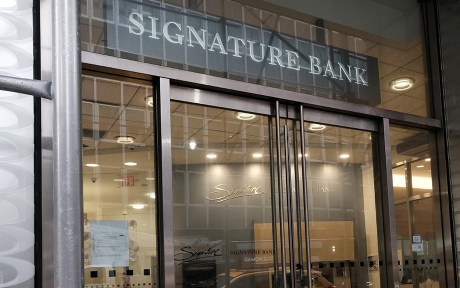
The collapse of Silicon Valley Bank (SVB) and Signature Bank (SB) has raised questions about the fragility of the banking system. One striking aspect of these bank failures is how the runs that preceded them reflect risks and trade-offs that bankers and regulators have grappled with for many years. In this post, we highlight how these banks, with their concentrated and uninsured deposit bases, look quite similar to the small rural banks of the 1930s, before the creation of deposit insurance. We argue that, as with those small banks in the early 1930s, managing the information around SVB and SB’s balance sheets is of first-order importance.
Managing Information about Individual Banks
Regulators have long recognized that public disclosure of banks’ balance sheets is an important tool that helps the market to discipline banks (see this work by E. White). Indeed, since the free banking era, banking regulators in the United States have required banks to report summary statistics of their balance sheets to the public on a periodic basis.
At the same time, regulators have also recognized that in a banking crisis, managing the information environment itself is important (see this paper for a review of the theory). In practice, this has often led to regulators suppressing information about banks’ balance sheets during a financial crisis. A classic example of this policy is President Franklin Roosevelt’s declaration of a bank holiday in March 1933, an action that, among other things, suppressed publicly available bank-level information in a bid to restore the public’s confidence in the solvency of the banking system.
Our empirical work provides evidence supporting this theory by demonstrating that increasing the opacity of a bank’s balance sheet during a crisis results in households keeping more of their deposits in that bank.
How Does Deposit Insurance Affect Information Management?
Deposit insurance plays a key role in the management of information about banks by taking away a depositor’s incentive to monitor a bank—making depositors information-insensitive. Wanting to maintain some market discipline, Congress capped the size of insured deposits, with the goal of creating two types of depositors: small, insured depositors and large, uninsured depositors. Because the larger depositors remain uninsured, they are likely to continue to monitor banks and thus restrict how much risk a bank places on its balance sheet.
At its inception, the Federal Deposit Insurance Corporation (FDIC) insured deposits up to $5,000. Using data published in the Federal Reserve Bulletin, we find that in September 1938, 98.4 percent of accounts at FDIC-insured banks were insured and about 45 percent of total deposits were insured. Although coverage varied widely among banks, in general the smaller banks reported that insured deposits represented a high share of total deposits and larger banks reported that they represented a lower share. For banks that were smaller in size (6,365 banks with total deposits less than $5 million), about 89 percent of deposits were insured. In contrast, for the largest 120 banks (those with deposits of over $50 million), approximately 25 percent of deposits were insured.
This distribution of insured and uninsured depositors resulted in smaller banks being well-protected from runs because their depositor base was largely insured. This was an attractive feature of the policy for two reasons.
First, the small banks in the 1930s were local institutions, in that their deposits came from geographically nearby households and their loans were made to surrounding businesses. This geographic concentration made depositor runs more likely because depositors could easily identify and communicate with one another.
Second, depositor insurance changed which types of depositors had the burden of monitoring banks. Given that the deposits of most households and small businesses were insured, these depositors no longer had an incentive to monitor banks’ balance sheets. In contrast, large firms, financial institutions, and banks themselves often held uninsured deposits, and therefore retained incentives to monitor banks and examine the amount of risk present on banks’ balance sheets. Indeed, in the 1930s when the FDIC was created, banks often had deposits at other (larger) banks and these interbank deposits served as a market disciplinary device. The change in which types of depositors were monitoring banks was attractive because the more financially savvy types were left monitoring banks on an active basis, a strategy that would likely discipline banks while averting inefficient runs (in other words, runs on healthy banks).
How Does This Apply to the Runs on Silicon Valley Bank and Signature Bank?
Since the 1930s the U.S. banking system has evolved to a tremendous extent. Nevertheless, the aggregate coverage of the FDIC deposit insurance program today is similar in percentage terms to what it was in 1937. Using recent call reports data, we find that 97 percent of accounts and 48 percent of total deposits are insured. So the recent bank runs and subsequent discussions of overall banking stability do not seem to reflect issues with changes to the overall coverage of deposit insurance.
Rather, we argue that SVB and SB are in the unusual position of looking like the small banks of the 1930s, before the FDIC offered deposit insurance. Both SVB and SB had a depositor base that looked local, in that depositors reportedly interacted with one another in their regular business dealings. SVB’s depositors were connected through venture capital networks and SB’s depositors were connected through law firm networks. Further, these depositors were largely uninsured and therefore sensitive to (negative) information about their bank’s balance sheet. Finally, the majority of SVB’s and SB’s depositors could be considered financially naïve, at least relative to the financial firms that drive the majority of uninsured deposits in the United States today.
Given these characteristics, both SVB and SB, like the small rural banks before the creation of the FDIC, should have been acutely aware of the importance of managing the information about their balance sheet. Fortunately, regulators and the banking system at large are aware of the importance of managing the information environment, especially in a crisis. Indeed, policy makers have repeatedly assured the public of the soundness of the banking system, and in a public show of confidence, some of the largest U.S. banks have placed deposits at First Republic Bank, a regional bank facing rumors about its creditworthiness, in a bid to quell a potential run by depositors. Looking ahead, our work emphasizes that banks need to remain aware of, and actively manage, the information about balance sheet risks that is presented to their depositors, especially in times of financial stress. This information includes classic measures on uninsured deposits and losses on asset holdings, as well as newer liquidity-based statistics that have been put into place since the 2008-09 financial crisis.
Haelim Anderson is a senior financial economist at the Federal Deposit Insurance Corporation (FDIC).

Adam Copeland is a financial research advisor in Money and Payments Studies in the Federal Reserve Bank of New York’s Research and Statistics Group.
How to cite this post:
By Haelim Anderson and Adam Copeland, “Banks Runs and Information,” Federal Reserve Bank of New York Liberty Street Economics, May 12, 2023, https://libertystreeteconomics.newyorkfed.org/2023/05/banks-runs-and-information/.
Disclaimer
The views expressed in this post are those of the author(s) and do not necessarily reflect the position of the Federal Reserve Bank of New York or the Federal Reserve System. Any errors or omissions are the responsibility of the author(s).











 RSS Feed
RSS Feed Follow Liberty Street Economics
Follow Liberty Street Economics